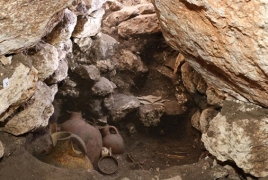3,600-year-old tomb skeletons could be the Canaanite elite of Megiddo March 15, 2018 - 12:34 AMT PanARMENIAN.Net - The discovery of a Middle Bronze Age tomb in the ancient Canaanite city of Megiddo provides a fascinating glimpse at what life was like for the rich and powerful before Thutmose's army overthrew its leaders in the early 15th century BC. Researchers are especially looking forward to learning about the origins of the ruling class at the time, Ancient Origins reports. Megiddo is most famous for at least three major battles on its soil: in the 15th century BC when Thutmose III fought against a huge coalition of Canaanites led by the head of Megiddo and the city of Kadesh, in 609 BC when Pharaoh Necho II fought King Josiah of the Kingdom of Judah, and when Allied troops faced the Ottoman army there in 1918. Archaeologists have been attempting to unlock the secrets of Megiddo, the city ancient Greeks referred to as Armageddon, for over a century. Excavations have revealed numerous monumental buildings such as palaces, temples, and old city walls, as well as an array of artifacts from the Bronze and Iron Ages (approximately 3300-586 BC). National Geographic reports archaeologists have recently stumbled upon a new feature of interest – a rich, untouched 3,600-year-old tomb. The discovery was made when cracks were noted near the surface of Bronze Age palaces identified in the 1930s. Dirt seemed to be spilling into an unknown chamber below. When the team began to explore the interesting feature in 2016, archaeologists unearthed a corridor leading to a burial chamber. When they looked inside, the researchers were delighted to find the undisturbed remains of a woman in her mid-30s, a man who died sometime between the ages of 40-60, and a child aged eight to 10 years old. All three were laid to rest with well-crafted gold, silver, and bronze jewelry such as necklaces, a diadem, rings, brooches, bracelets, anklets, and pins. The tomb was dug for elite Middle Bronze Age members of Megiddo’s society. Israel Finkelstein told National Geographic how the researchers came to this conclusion, “We are speaking of an elite family burial because of the monumentality of the structure, the rich finds and because of the fact that the burial is located in close proximity to the royal palace.” But the rich grave does not just attest to the wealth of the family inside; it also indicates that Megiddo was a cosmopolitan and wealthy site during the Middle Bronze Age. Ceramic vessels from Cyprus and stone jars which may have Egyptian origins promote the idea of trade between Megiddo and these locations. Authorities said a total of 192 Azerbaijani troops were killed and 511 were wounded during Azerbaijan’s offensive. In 2023, the Azerbaijani government will increase the country’s defense budget by more than 1.1 billion manats ($650 million). The bill, published on Monday, is designed to "eliminate the shortcomings of an unreasonably broad interpretation of the key concept of "compatriot". The earthquake caused a temporary blackout, damaged many buildings and closed a number of rural roads. Partner news |